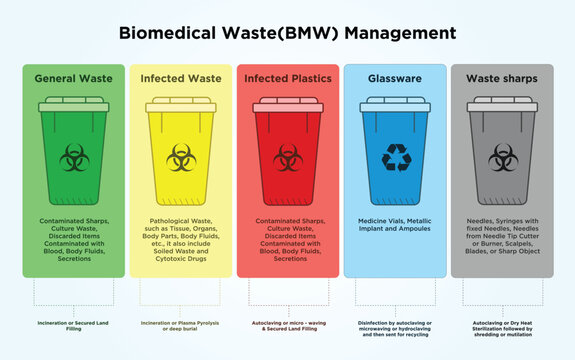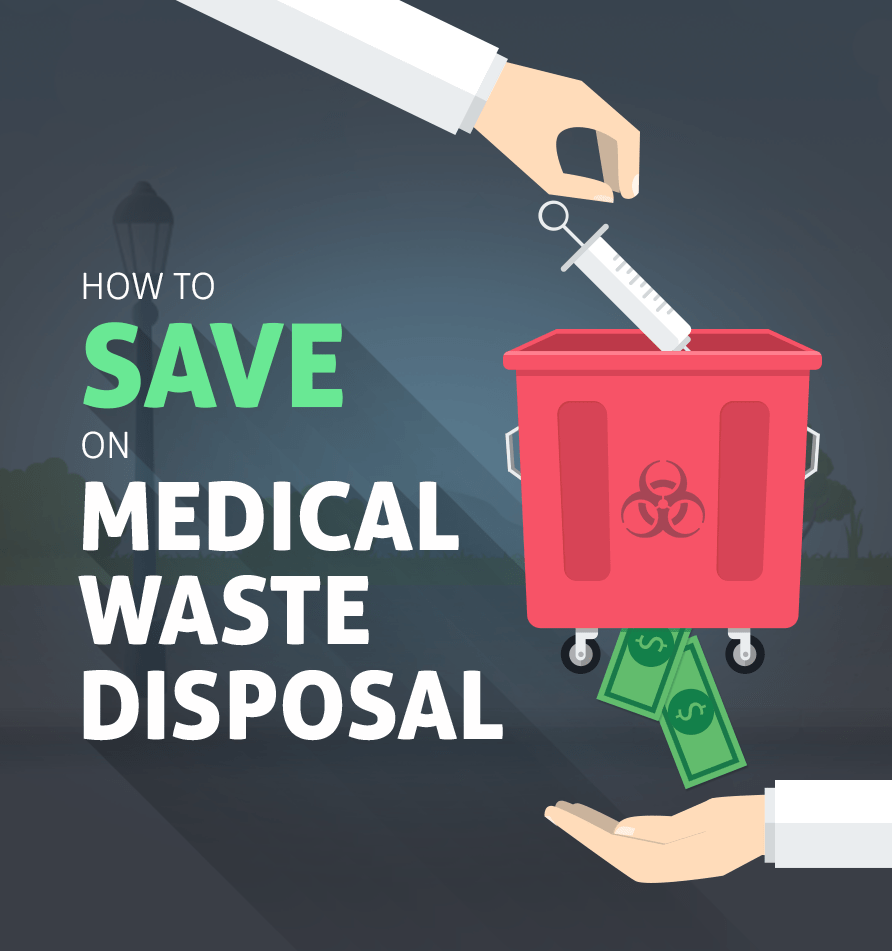Comprehensive Medical Waste Disposal Services: Making Sure a Healthy And Balanced Setting
Wiki Article
Compliance and Rules for Medical Waste Disposal
Conformity and guidelines for medical garbage disposal play a crucial role in making sure the safety and security and health of both health care experts and the public. Proper monitoring of medical waste is necessary to protect against the spread of infections, safeguard the setting, and preserve public wellness. This requires adherence to particular standards and procedures established forth by regulatory companies and bodies. These regulations include numerous aspects, consisting of the classification and partition of medical waste, appropriate storage space and handling procedures, along with transportation and disposal techniques. By adhering to these regulations, health care centers can reduce the danger of contamination and possible harm to individuals and the atmosphere. This write-up will check out the value of conformity and offer an introduction of the vital policies regulating clinical garbage disposal.Importance of Compliance
The relevance of conformity with guidelines for clinical garbage disposal can not be overstated. Proper disposal of medical waste is essential for ensuring the safety and wellness of health care workers, patients, and the basic public. Clinical waste, which consists of items such as used needles, infected handwear covers, and biomedical waste, can present severe health and wellness dangers if not taken care of and disposed of properly.Conformity with policies ensures that clinical waste is managed in a manner that lessens the capacity for exposure to transmittable conditions and unsafe substances - medical waste removal service. It helps avoid the spread of infections, such as HIV, hepatitis B and C, and various other bloodborne microorganisms. Conformity likewise plays an essential function in shielding the environment by stopping contamination of water resources, soil, and air
Failure to abide by guidelines can lead to serious repercussions for healthcare facilities, consisting of penalties, lawsuit, and damage to their online reputation. Additionally, non-compliance might jeopardize the wellness and safety and security of health care workers, clients, and the neighborhood.
Compliance with regulations for medical garbage disposal needs adherence to particular guidelines and methods. These might consist of appropriate partition, product packaging, labeling, and storage space of clinical waste. It additionally involves utilizing accepted disposal methods, such as incineration, autoclaving, or landfilling, relying on the kind of waste.
Regulative Agencies and Bodies
Governing agencies and bodies play an essential function in managing conformity with regulations for medical waste disposal. These companies are accountable for setting standards, standards, and methods to make sure the secure and appropriate handling of medical waste. They monitor and enforce compliance to safeguard public health and the environment.One of the most popular governing companies in the USA is the Environmental Security Agency (EPA) The EPA is in charge of regulating the storage, transport, treatment, and disposal of clinical waste. They develop guidelines for waste generators, transporters, and therapy facilities to adhere to, guaranteeing that all necessary safety measures are taken to avoid the spread of conditions and contamination.
One more vital governing body is the Occupational Safety And Security and Health And Wellness Administration (OSHA) OSHA sets requirements and laws to shield employees from work threats, including those relevant to clinical waste. WasteX Medical Waste Disposal. They give guidelines for the risk-free handling and disposal of clinical waste to secure employees in healthcare centers
Along with these federal firms, individual states additionally have their very own regulative bodies that supervise medical garbage disposal. These agencies might have their very own details policies and requirements that need to be complied with.

Classification and Partition of Clinical Waste
To guarantee proper management of medical waste, it is vital to classify and segregate it according to established standards and procedures. medical waste removal service. Classification and partition play an important role in lessening the threat of infection, protecting the environment, and making certain the safety of health care workers and the general publicMedical waste is categorized right into various groups based upon its potential hazard degree. These groups consist of transmittable waste, pathological waste, sharps waste, pharmaceutical waste, chemical waste, and radioactive waste. Each category calls for certain handling, disposal, transport, and storage space techniques to lessen the danger of direct exposure and contamination.
Segregation of medical waste entails dividing various kinds of waste at the source. This procedure makes sure that waste with various hazard degrees is not blended, reducing the possibility for cross-contamination and making disposal procedures extra efficient. Proper segregation is achieved with the use of color-coded labels and containers, which help medical care employees and waste monitoring workers determine and deal with each kind of waste correctly.
Along with category and segregation, healthcare centers have to additionally follow regional, state, and government policies concerning medical waste monitoring. These guidelines describe certain needs for storage space, transportation, treatment, and last disposal of clinical waste, ensuring compliance and preserving public wellness and safety.
Appropriate Storage Space and Taking Care Of Procedures
Appropriate storage space and managing treatments play a crucial role in ensuring the compliant and secure management of medical waste. Medical waste, which includes products such as made use of syringes, polluted handwear covers, and ended drugs, can present major wellness and ecological dangers if not dealt with correctly. Consequently, it is vital for medical care centers and various other generators of clinical waste to carry out rigorous storage and taking care of procedures.
To start with, clinical waste needs to be kept in resilient, leak-proof containers that are especially made for this function. These containers must be labeled with the universal biohazard icon and the words "medical waste" to plainly indicate the components. Furthermore, the containers must be kept safely near avoid any kind of possible leakage or spillage.
Moreover, it is vital to set apart various kinds of clinical waste to avoid cross-contamination. Sharps, such as needles and scalpels, must be saved in puncture-resistant containers to reduce the danger of injuries - WasteX Medical Waste Disposal. Chemical waste, such as solvents and anti-bacterials, should be stored separately from other types of medical waste to avoid chain reactions or dangerous exposures

Transport and Disposal Methods
Medical care facilities have to make sure the secure transportation and correct disposal of their clinical waste to adhere to regulations and secure public health. Transport and disposal techniques play a crucial role in avoiding the spread of contagious diseases and reducing the ecological effect of medical waste.
To transfer clinical waste, health care centers need to use puncture-resistant and leak-proof containers that are labeled with the biohazard icon. These containers need to be securely secured to avoid any leakage throughout transportation. Additionally, medical care centers should establish procedures for the transportation procedure, including using skilled employees and devoted cars.
As soon as the clinical waste gets to the disposal center, it undergoes different methods of therapy - WasteX Medical Waste Disposal. One usual more information method is incineration, which entails burning the waste at high temperatures to damage pathogens and minimize the volume of waste.
It is vital for medical care centers to collaborate with licensed and allowed waste monitoring companies to make certain proper transportation and disposal of clinical waste. These companies have the experience and resources to take care of clinical waste securely and in compliance with policies.
Verdict
In final thought, compliance with policies for medical waste disposal is of utmost value to make certain public wellness and security. On the whole, adherence to conformity and laws is required to successfully take care of clinical waste.Medical waste, which consists of products such as utilized needles, polluted handwear covers, and biomedical waste, can present severe wellness risks if not dealt with and disposed of correctly.
These classifications include contagious waste, pathological waste, sharps waste, pharmaceutical waste, chemical waste, and radioactive waste.Segregation of medical waste involves dividing various kinds of waste at the resource. Appropriate segregation is attained through the use of color-coded tags and containers, which help health care employees and waste management workers manage each kind and recognize of waste correctly.
Chemical waste, such as solvents and disinfectants, must be saved independently from various other types of medical waste to avoid unsafe direct exposures or chemical reactions.
Report this wiki page